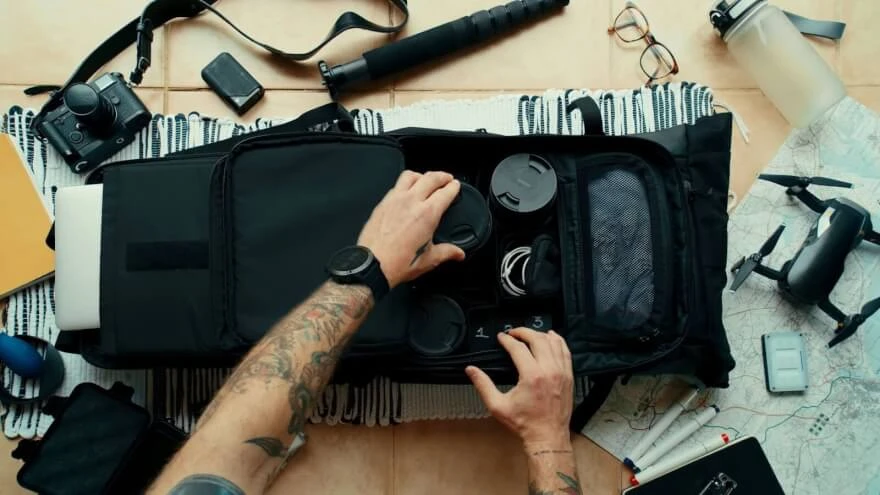How to store camera lenses?

- Significance of Proper Storage
- Clean Before Storage
- Goods and Bads for wiping the lens
- What liquid to use for cleaning the lens?
- Use Lens Caps and Hoods
- How to Store Camera Lens in Bag
- Control Humidity
- Temperature Considerations
- How to Store Lenses Long-Term
- Conclusion
Lenses are a crucial part of any camera allowing you to adjust focal length, have an aperture control, and the depth of field control. You can utilize lenses to do many things, and there would be no such things as fisheye lens photography, wildlife photography, or macro photography without the lenses. Hence, it is important to know how to properly care about your gear, and how to store camera lenses when not in use. There are plenty of ways to store lenses for short and long terms with their cons and pros. There are also plenty of factors that you need to consider when storing your gear such as humidity, proper cleaning, and carrying. In this article, we are going to cover all these things and elaborate on what can affect your lenses and how to prevent that from happening.
Significance of Proper Storage
The significance of proper storage for camera lenses lies in the preservation of their optical integrity and overall performance. When it comes to storing lenses, photographers have several approaches to choose from, each with its own set of pros and cons. In essence, the choice of lens storage method is a personal decision shaped by individual preferences, the quantity of lenses in possession, and the frequency of their usage. This imperative applies universally, catering to both seasoned professional photographers and avid amateur enthusiasts alike. The meticulous care invested in lens storage directly correlates to the lenses' ability to consistently deliver high-quality images, making it a cornerstone of responsible gear management. Let's take a look at how to store a camera lens, what care it requires, and the different ways of storing and transporting them.
Clean Before Storage

If you appreciate your gear, you will always take care of it by cleaning it while using it. Before stashing your camera lenses away, it's also imperative to clean them thoroughly. Remove any dust, fingerprints, or smudges using a gentle lens cleaning solution and a microfiber cloth. Clean optics not only improve image quality but also prevent the accumulation of contaminants that can lead to long-term damage. Make sure to let the lens dry out if you wipe it with a watered cloth before storing. Learn more in the “Control Humidity” paragraph.
Goods and Bads for wiping the lens
Any wood pulp base like a paper towel or Kleenex is a bad idea, it is abrasive and leaves junk all over the front of your lenses. Microfiber cloth is your best choice here, like you use for eyeglasses for example. It absorbs liquid pretty well and its texture is not as abrasive as the mentioned examples.
What liquid to use for cleaning the lens?
You never want to wipe a dry lens cloth on a lens, so we need some sort of liquid. Most people use their own breath combined with a T-shirt for that matter, but we don’t recommend doing that. Purchase some good optical lens cleaners as they are isopropyl alcohol with good evaporation factor while at the same time still working better cleaning, unlike water that deals badly with fingerprints as they are leaving fat that does not dissolve in water. Make sure to spray liquid onto the cloth and never directly on the lens because a lot of them are not waterproof.

Important note: Do not wipe your lens if you clearly see some sand particles on it, as its abrasive nature may cause significant damage to your lens during wiping over time. Use a blower bulb combined with a soft brush to get rid of harsh particles and then use liquid and microfiber cloth to finish cleaning. Lens’ glass is quite rigid and is able to endure even some metal scratches, but the small particles of dust are an actual killer here.
Use Lens Caps and Hoods

Lens caps and hoods should be considered not only for transporting and protection while traveling but also as a way to store the gear. Lens caps and hoods act as the first line of defense against potential damage. Always use the lens cap when the camera lens is not in use to protect the front element from scratches, dust, and other elements. Lens hoods, on the other hand, shield the lens from stray light, reducing the chances of lens flares and enhancing contrast.
How to Store Camera Lens in Bag

When on the move, use a sturdy backpack or camera bag designed for travel. Ensure each lens is securely in place and protected from shocks during transit. This extra precaution helps prevent accidental damage while you're on the go. One common method is individual lens cases within a larger camera bag. This approach offers excellent protection against impacts, scratches, and dust. The individual cases ensure that each lens has a designated space, minimizing the risk of accidental damage during transportation. However, this method may be less space-efficient and could result in a bulkier setup. A camera backpack with customizable dividers offers a balance between protection and convenience. The dividers allow for a tailored arrangement of gear, and the backpack design ensures ease of transport. Nevertheless, it may lack the specialized protection provided by individual lens cases.
Control Humidity
Any gear is highly affected by a bad humidity factor. Humidity can be detrimental to lens health, leading to mold and fungus growth inside. Fungus is when you look at your lens glass and see a nasty little spidery spot inside. Fundamentally it is caused by bad storage and bad humidity control. Fungus loves damp, enclosed airless environments and darkness. If you are storing your equipment inappropriately it will affect and grow on organic matter (leather camera straps, canvas cases, optical coatings).

The first precautionary method is to make sure to let your lens dry out after wiping it out. Then there are plenty of ways to control the humidity:
If you have no other option but to store your lens on a shelf, then you want to purchase a humidity sensor to see if the area is secure.

There are also more expensive solutions, such as dedicated cabinets that dehumidify.

If you can’t invest hundreds and thousands of dollars into that luxury, you may consider a simple solution. As such a plastic bag with a foam liner to make sure that air doesn’t go inside that much is a good starting point.

Additionally, you can put a silica gel package inside to de-humidify the air that may get inside the box bypassing the foam that may deteriorate over time. This measure is enough to prevent mold and fungus from growing and humidity control is also a way to protect your gear from rusting of its metal elements. OSG-40 SIlica Gel can be found on Amazon for $15-20 per package on average. When you see the gel balls turn from orange to clean this means they have absorbed all the moisture that they are going to absorb and require replacement. Or you can just put them into the oven at 300 degrees Fahrenheit for 3-4 hours and you have them recharged and orange – ready for use again.

If you came from a rainy weather photoshoot, before storing your lens inside a box, let it dry. Make sure there is air flowing allowing things to dry out and not deposit the moisture inside the closed box. To speed this up, use a loom cube on 50% power that will generate the heat. To increase the airflow you can use a USB fan as well. A combination of those elements works perfectly even in closed conditions, and you can flow the moisture navigating it to the silica gel while the loom cube heats things up.

Having humidity control provides overall endurance of your lens and especially its moving parts. As we mentioned earlier, fungus like three factors: humidity, darkness, and confined areas. As we have done dealing with humidity, we still use confined storage, and that is why having some light pointed at your gear will improve the chances of preventing fungus from growing inside in case there are airflow leaks in the compartment of your lenses. Put your gear on sunlight from time to time, because fungus hates ultraviolet, or use artificial UV lights instead.
Temperature Considerations
Extreme temperatures can also adversely affect lens performance. Avoid storing your camera lenses in areas prone to temperature fluctuations, such as attics or basements.

Humidity and temperature are two related factors. If you store your lens in ever-shifting temperature conditions, the air around your lens still has humid particles that can transform into moisture from vapor back and forth depending on temperature. So make sure to store your lens in places with solid temperature and humidity control as these depend on each other. Optimal storage temperatures range between 32°F to 95°F (0°C to 35°C) to prevent issues like condensation and lens element expansion.
How to Store Lenses Long-Term

- For extended periods of non-use, consider removing the lenses from your camera body. Store them in a vertical position to minimize stress on the lens mount.
- If you are going to store your lenses for the long term and you have a large collection, it is important to rotate moving parts from time to time to maintain functionality and prevent rusting the moving parts. This practice ensures that each lens gets its fair share of usage, preventing any single lens from sitting idle for too long. Regular rotation also aids in detecting potential issues early on.
- Store your lenses vertically in a lens cabinet or dedicated storage shelf. This approach maximizes space efficiency and allows for easy access to different lenses. However, it may expose the lenses to more dust and requires careful handling to avoid accidental knocks.
- Apply humidity control tips here as well.
Conclusion

Proper camera lens storage is an essential aspect of camera care. By following these guidelines on lens storage, you can protect your investment, maintain optimal performance, and ensure that your camera lenses are always ready to capture the perfect shot. Taking the time to store your lenses correctly is a small effort that pays off in the long run, preserving the quality of your photographic gear. In the end, the choice of lens storage method depends on individual preferences, the volume of lenses owned, and the frequency of use. Photographers should weigh the pros and cons of each approach to find the best fit for their specific needs, ensuring that their lenses remain in optimal condition for years to come.
Co-founder of RetouchMe. In addition to business, he is passionate about travel photography and videography. His photos can be viewed on Instagram (over 1 million followers), and his films can be found on his YouTube channel.
Moreover, his profile is featured on the most popular and authoritative resource in the film industry — IMDb. He has received 51 international awards and 18 nominations at film festivals worldwide.

with RetouchMe














